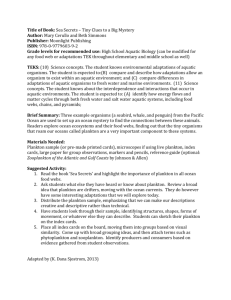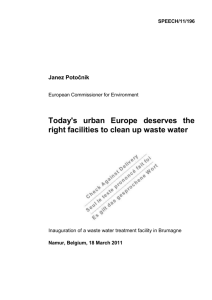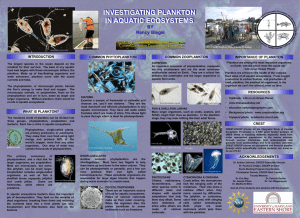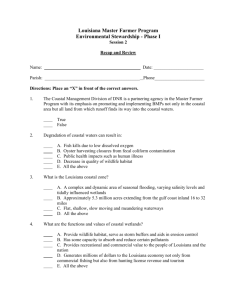NARA ship - National Aquatic Resources Research and
advertisement
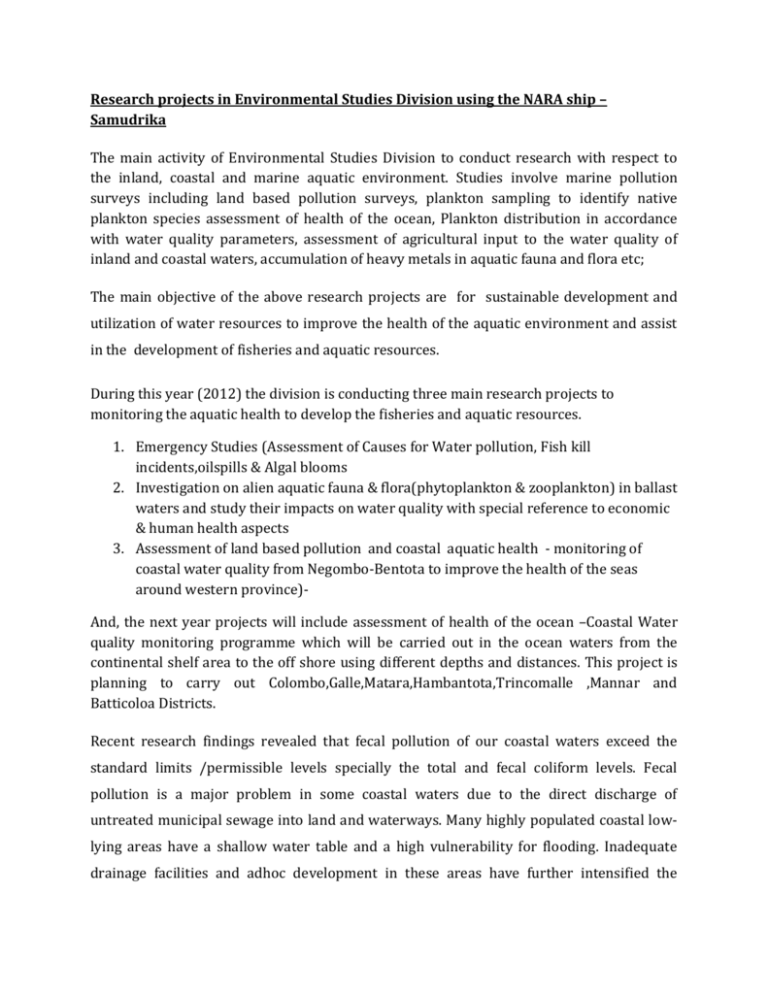
Research projects in Environmental Studies Division using the NARA ship – Samudrika The main activity of Environmental Studies Division to conduct research with respect to the inland, coastal and marine aquatic environment. Studies involve marine pollution surveys including land based pollution surveys, plankton sampling to identify native plankton species assessment of health of the ocean, Plankton distribution in accordance with water quality parameters, assessment of agricultural input to the water quality of inland and coastal waters, accumulation of heavy metals in aquatic fauna and flora etc; The main objective of the above research projects are for sustainable development and utilization of water resources to improve the health of the aquatic environment and assist in the development of fisheries and aquatic resources. During this year (2012) the division is conducting three main research projects to monitoring the aquatic health to develop the fisheries and aquatic resources. 1. Emergency Studies (Assessment of Causes for Water pollution, Fish kill incidents,oilspills & Algal blooms 2. Investigation on alien aquatic fauna & flora(phytoplankton & zooplankton) in ballast waters and study their impacts on water quality with special reference to economic & human health aspects 3. Assessment of land based pollution and coastal aquatic health - monitoring of coastal water quality from Negombo-Bentota to improve the health of the seas around western province)And, the next year projects will include assessment of health of the ocean –Coastal Water quality monitoring programme which will be carried out in the ocean waters from the continental shelf area to the off shore using different depths and distances. This project is planning to carry out Colombo,Galle,Matara,Hambantota,Trincomalle ,Mannar and Batticoloa Districts. Recent research findings revealed that fecal pollution of our coastal waters exceed the standard limits /permissible levels specially the total and fecal coliform levels. Fecal pollution is a major problem in some coastal waters due to the direct discharge of untreated municipal sewage into land and waterways. Many highly populated coastal lowlying areas have a shallow water table and a high vulnerability for flooding. Inadequate drainage facilities and adhoc development in these areas have further intensified the impacts of inappropriate sewage disposal in low-lying flood prone coastal areas leading to severe fecal pollution in internal and near shore waters. Therefore one of future research activities of the division aims assessment of ocean health with special reference to microbiological analysis of water quality monitoring. The other research projects of the division involve plankton sampling to identify native plankton species and Plankton distribution in accordance with water quality parameters. Plankton are the productive base of both marine and fresh water ecosystems, providing food for large animals and indirectly for human, whose fisheries depends on plankton. Zooplankton are used directly as food by fish or mammals, but several links on the food chain usually have been fast before plankton is available for human consumption. The introduction of invasive marine species into new environments by ships’ ballast waters attached to ships’ hulls and via other vectors has been identified as one of the four greatest threats to the world’s oceans. Coastal port areas are home to a wide variety of organisms that live in the water and bottom sediments. Some of the species that do survive the trip are able to thrive in their new environment. These bioinvaders can cause disruptions in the natural ecosystem, economic troubles, and even carry human diseases.Many aquatic invasive species can cause major economic impacts on human society. Direct economic losses to society can be caused by aquatic bio-invasions in a number of ways, including reductions in fisheries production (including collapse of the fishery) due to competition, predation and/or displacement of the fishery species by the invading species, and/or through habitat/environmental changes caused by the invading species and impacts on aquaculture (including closure of fish-farms), especially from introduced harmful algae blooms. And also Secondary economic impacts from human health impacts of introduced pathogens and toxic species, including increased monitoring, testing, diagnostic and treatment costs, and loss of social productivity due to illness and even death in affected persons. Therefore one of our projects aims identifying alien aquatic fauna & flora (phytoplankton & zooplankton) in ballast waters and studies their impacts on water quality with special reference to economic & human health aspects and also to identify whether there is any impacts on fisheries and aquaculture to management of fisheries and aquaculture.
